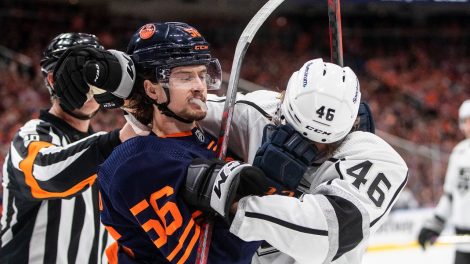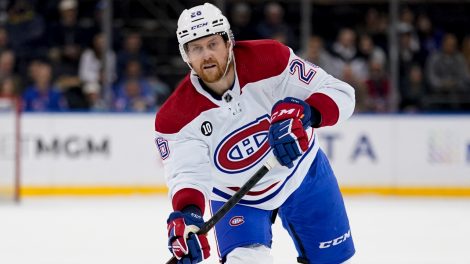Winning comes at a cost.
“When we’re not dealing with cap issues, we’re probably rebuilding,” Toronto Maple Leafs president Brendan Shanahan recently explained on Prime Time Sports.
“The better you become, the less peaceful it is, the more anxiety there is, because each decision means more and so you still have problems.
“They’re just better problems.”
Embrace the rebuild and watch your salary cap concerns tumble to the floor.
But try to win today, and you’ll sweat every penny spent.
So although the NHL clubs facing the greatest cap crunches took vastly different routes to reach their summer of tough decisions and inevitable roster casualties, they all have one thing in common: they’re striving to be on the ice come May 2020.
While we await an official announcement of the 2019-20 cap ceiling, we dive into the cap issues facing the seven teams believed to have the greatest challenge working with the league’s projected $83-million salary cap.
Something’s gotta give.
[relatedlinks]
Vegas Golden Knights
Projected cap space: $0 
Ah, it seems like only yesterday when George McPhee was staring at every general manager’s dream: a blank Excel sheet for him to fill as he wished. Now, two summers later, as McPhee hands the keys and the headaches to his successor, Kelly McCrimmon, the Golden Knights’ books resemble those of a serious contender who made splashes at the deadline (Mark Stone) and was aggressive in free agency (Paul Stastny, Ryan Reaves).
It’s McCrimmon’s first off-season in the GM seat, and he already in the red — $124,999 over the projected $83-million cap ceiling, with four empty slots on the 23-man roster still to fill.
One of those positions should belong to top-line, two-way centre William Karlsson, who bet on himself by taking a one-year deal last summer and is an RFA again. Decisions must also be made on backup goalie Malcolm Subban (RFA), heart-and-soul alternate captain Deryk Engelland (UFA), plus depth forwards Brandon Pirri (UFA), Ryan Carpenter (UFA), Pierre-Edouard Bellemare (UFA), Nikita Gusev (RFA) and Tomas Nosek (RFA). Oh, baby.
Right-shot defender Colin Miller ($3.875-million cap hit through 2021-22) is prime trade bait; he’s only 26, and he’s reportedly on the block. Massive relief could come in the form of moving David Clarkson’s contract ($5.25 million for one more season) to a team in need of hitting the floor (Ottawa?). Of course, such a trade would require Vegas sweetening the deal with picks and/or players.
McCrimmon has an extra 2020 second-round pick and two extra 2019 third-rounders he can use as currency in a salary-dump deal.
Pittsburgh Penguins
Projected cap space: $3.9 million 
So, Phil Kessel is totally getting traded again, isn’t he?
“There could be big changes, big changes,” Penguins no-nonsense GM Jim Rutherford announced upon his club’s embarrassingly easy playoff ouster by the New York Islanders. “Every possibility is on the table right now.”
As long as Sidney Crosby can lace up skates, Pittsburgh won’t be interested in a full-blown rebuild, so the Pens will be aggressively exploring trade options to improve the supporting cast — even if that entails dealing a point-per-game ironman.
The thrill is gone.
Onetime league MVP Evgeni Malkin (whose contract features a full no-move clause) hasn’t been able to escape the trade rumours that have touched everyone from Kris Letang to Olli Maata and are sure to ramp up over the next month.
Rutherford has already spend his second-, third- and sixth-round picks at the Vancouver draft, so his roster players are his best chips to play if he wants to shake things up.
Kessel’s contract ($6.8-million cap hit through 2021-22, with $1.2 million annually retained by Toronto) would provide the most relief, and there are plenty of cap-flexible clubs that could use the offence (Carolina, New Jersey, Islanders, Buffalo). He and Letang would be much easier to move than, say, 32-year-old Patric Hornqvist — set to be overpaid at $5.3 million for four more seasons. Hornqvist had only 37 points in 2018-19.
Rutherford needs to give raises to young forwards Teddy Blueger and Zach Aston-Reese, and he has one more season of Matt Murray at the bargain price of $3.75 million before the starting goalie raids the vaults.
Another option here could be trading the intriguing but oft-injured Justin Schultz. The 28-year-old is entering his walk year and didn’t live up to his $5.5 million in 2018-19.
Tampa Bay Lightning
Projected cap space: $8.6 million 
Regardless of whether the Presidents’ Trophy winners had enjoyed some post-season success or not, they were headed for a shake-up. Rookie GM Julein BriseBois is set to watch three veteran defencemen walk (Anton Stralman, Dan Girardi, Braydon Coburn) and still won’t have enough money left over to sign stud two-way centre — and this summer’s most valuable restricted free agent — Brayden Point to the type of long-term, tax-free (!) contract he’s earned.
Useful depth forwards Adam Erne and Cedric Paquette are also impending RFAs due for a pay bump, and it’s a thinly veiled secret that Tampa will at least explore the possibility of adding marquee UFA Erik Karlsson to its all-star squad.
All of which spells cap hell.
Where can the relief come?
• Not matching a Point offer sheet, if those things still exist.
• Buying out the final year and $5.8 million of Ryan Callahan’s contract, if the alternate captain can’t be packaged into a trade.
“It doesn’t take a scientist right now to figure out I’m on the outside looking in,” Callahan told The Athletic.
• Trading a middle-class twentysomething forward off the roster. Expect to see names like J.T. Miller ($5.25 million), Tyler Johnson ($5 million cap hit) and Alex Killorn ($4.45 million) pop up on your favourite rumour site. These are good players on reasonable deals, but the cap system is designed to squeeze them out.
Toronto Maple Leafs
Projected cap space: $8.8 million 
“As long as we are hopefully a Stanley Cup contender, we will have cap issues,” Shanahan said last week. “So Toronto should get used to that.”
The consensus is that, one way or another, an extension with franchise winger and two-time leading scorer Mitchell Marner (RFA) will get done. But it’s coming at the expense of re-signing top-four defenceman Jake Gardiner and makes difficult GM Kyle Dubas’s ability to extend both RFAs Andreas Johnsson and Kasperi Kapanen to juicy extensions after their breakout 20-goal campaigns.
We’ve already taken a deep dive into the ways Dubas can relieve his cap situation, which is being compromised by his hording of top-end forward talent and the final, buyout-proof season of Patrick Marleau’s contract.
Even with the 2019-20 Leafs expected to draw on cheap, entry-level talent from Toronto’s excellent farm system and likely to trade away a familiar face or two, Dubas will have to get creative to fill in the gaps on a blue line that already needed improvement.
Anaheim Ducks
Projected cap space: $9.1 million 
The good news (I guess) is that the Ducks don’t have any young superstar RFAs they need to re-sign. The bad news is that rapidly declining Corey Perry, significantly injured Ryan Kesler, and captain Ryan Getzlaf, who’s coming off the worst season of his life, are eating up a combined $23.75 million for the next two seasons. Bonus: Full no-move clauses for everyone.
Now, GM Bob Murray will see a measure of relief by moving Kesler — unlikely to play in 2019-20 as he recovers from hip resurfacing surgery — to long-term injured reserve, and there are several nice entry-level talents in the system (Sam Steel, Maxime Comtois, Max Jones, Troy Terry) who could step up and contribute.
But Murray has five roster spots to fill, including a reliable backup to support all-star John Gibson in net, and his depth at the centre and defence positions — once an Anaheim hallmark — have weakened over the past two years due to age, injury and trades.
Washington Capitals
Projected cap space: $10.1 million 
The 2018 champions’ cap pain will result from a thousand tiny cuts.
Brian MacLellan has just 16 contracts on the books for 2019-20 and a number of players set to either walk or get raises.
Nic Dowd, Nick Jensen and Pheonix Copley were all re-signed in-season and will all see their respective cap hits rise, pushing others out.
The Caps’ unrestricted free agents are Brett Connolly, who picked a fine time for a career season (22 goals, 46 points), Carl Hagelin, Devante Smith-Pelly and Brooks Orpik.
Desirable RFAs Jakub Vrana and Christian Djoos should return but with larger paycheques.
“We’ll have some decisions to make,” said MacLellan upon playoff elimination. “Some of it’s money decisions. Some of it’s we need to make a couple changes.
“Depending on what we decide to do, you might have to create some space and just go from there.”
That is ominous news for players like Andre Burakovsky, Chandler Stephenson and Dmitrij Jaskin, who could be in for tough RFA negotiations.
The Burakovsky trade murmurs could get loud again. Or MacLellan might decide to not qualify the winger (at $3.25 million), riskily letting him hit the open market at age 24.
Top-four, right-shot defenceman Matt Niskanen, 32, carries a cap hit of $5.75 million for the next two seasons and would have trade value despite a mediocre year.
Lurking in the background of GMBM’s immediate cap decisions are Nicklas Backstrom ($6.7-million cap hit) and Braden Holtby ($6.1 million). Both stars are entering walk years and are eligible to ink juicy extensions on July 1.
Edmonton Oilers
Projected cap space: $10.8 million 
Hockey’s most reliable finance site, CapFriendly.com, has a handy buyout calculator, and at one point last week, Milan Lucic, Andrej Sekera, Sam Gagner and Kris Russell were all crowding on the top eight most-searched buyouts by users.
Such is the mess new GM Ken Holland is getting handsomely paid to mop up.
Edmonton has already committed $67.3 million to 15 players (eight forwards, six defencemen and one goalie) for Holland’s first season at the helm, and the new guy ain’t rebuilding — at least not on purpose.
We’d toss starting goalie (for now) Mikko Koskinen’s paperwork onto the heap of unfriendly deals here, meaning Holland must spend some of his limited funds on a goaltender who can backstop this group back to springtime relevance.
The seasoned exec does have movable pieces in Ryan Nugent-Hopkins and Adam Larsson, but trading an actual talent will just create another hole to fill. Which is why fans keep circling back to buyout fantasies.
The silver lining in Oil Country can be found in Bakersfield, where cheap, skilled defencemen are preparing for their shot. But Holland likes to over-ripen his prospects, and Connor McDavid wants to win now.
Add underwhelming prospect Jesse Puljujarvi’s uncertain future to Holland’s to-do list. The Finn’s trade value is achingly low, and he’s set to become a restricted free agent.









